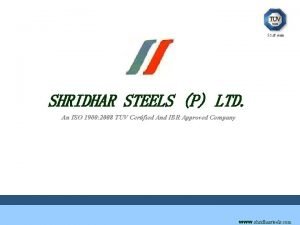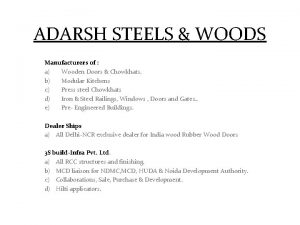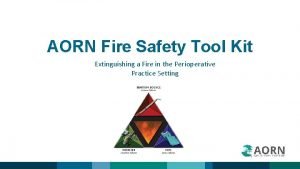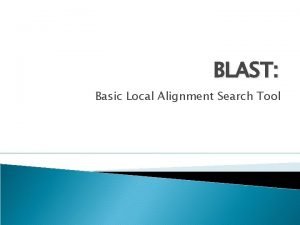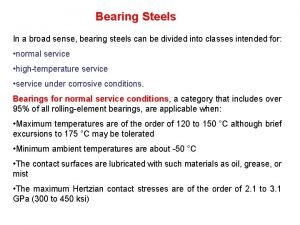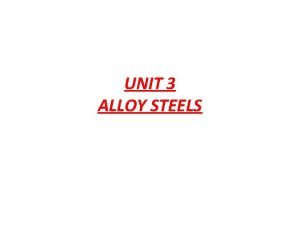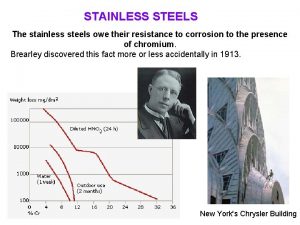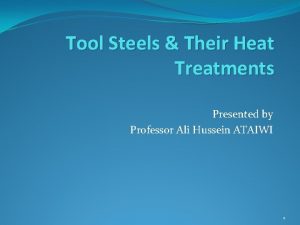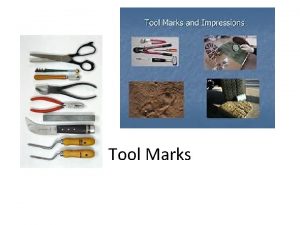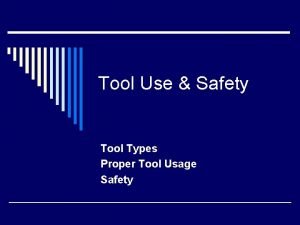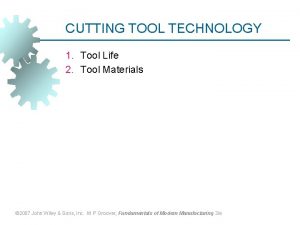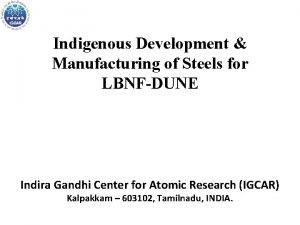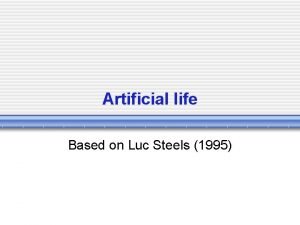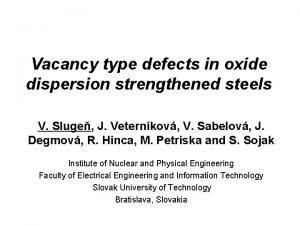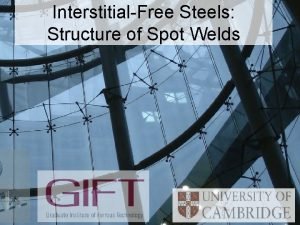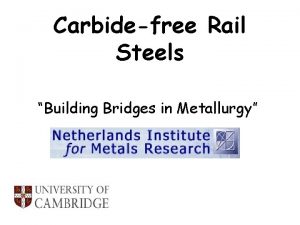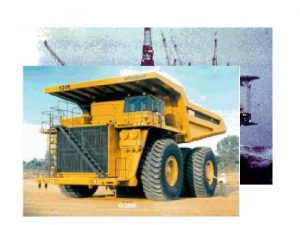TOOL STEELS TOOL STEELS Tool steels are steels





















- Slides: 21

TOOL STEELS


TOOL STEELS Tool steels are steels that are primarily used to make tools used in manufacturing processes as well as for machining metals, woods, and plastics. Tool steels must be able to withstand high specific loads as well as be stable at elevated temperatures. Standard BS 4659: 1971 groups tool steels into six types: 1. high speed 2. hot work 3. cold work 4. shock resisting 5. special purpose (finishing steels) 6. water hardening 7. High-speed steels are very efficient with heavy cuts and high speeds they are incapable, at slow speeds and lighter cuts, of holding the keen edge necessary for obtaining a very smooth finish on certain articles. Special steels have been produced for this purpose, known as finishing steels, which are capable of retaining a keen cutting edge for much longer periods than carbon steel used under similar conditions.

Plain carbon steels, if used for cutting tools, lack certain characteristics necessary for high-speed production, such as red hardness and hot strength toughness. The effect of alloying elements in steel is of great advantage and yields tool steels that overcome many of the shortcomings of the plain carbon steels. Tool steels are defined by U. S. steel producers as "carbon or alloy steels capable of being hardened and tempered". Many alloy steels would fit this loose definition. Tool steels usually contain significantly more alloying elements than alloy steels. However, the real factor that discriminates tool steels from carbon or allot steels is the manufacturing practice. Tool steels have properties that permit their use as tools for cutting and shaping metals and other materials both hot and cold.

A prefix letter is used in the alloy identification system to show use category, and the specific alloy in a particular category is identified by one or two digits: S 1 = Shock resistant tool steel D 2 = Cold-work tool steel H 11 = Hot work tool steel M 42 = High-speed tool steel

One problem that exists in discussing the metallurgy of tool steels is that, since there are six major categories of tool steels, it is difficult to make statements that apply to all these steels. The following ae some of the characteristics of tool steels: 1. Composition and physical properties vary significantly 2. One important factor that should be kept in mind is that the alloy additions do not improve corrosion resistance even though some grades have as much chromium as stainless steels. The reason for this is that alloy elements are usually combined with carbon to form carbides. 3. The most significant metallurgical difference between tool steels and the other steels is their microstructure. A fully hardened carbon steel or alloy steel would have only martensite as the predominant phase. Most tool steels have a hardened structure of martensite and alloy carbides.

4. Require special heat treatment processes 5. Higher cost than alloy steels (The cost of the steel and its heat treatment amounts generally to less than a quarter of the total cost of the whole tool) 6. Better hardenability than most carbon and alloy steels, 7. High heat resistance 8. Easier to heat treat 9. More difficult to machine than carbon and alloy steels 10. Most tool steels are sold as hot-finished shapes such as rounds and bars 11. Cold-finished sheets are not available because it is difficult to cold roll or cold finish these materials.

HIGH SPEED TOOL STEELS High-speed alloys include all Mo and W class alloys. High-speed tools steels can be hardenend to 62 -67 HRC and can maintain this hardness in service temperatures as high as 540 °C, making them very useful in highspeed machinery. The evolution of high-speed cutting tools commenced with the production of Mushet`s self-hardening W-Mn steel in 1860. The possibilities of such steels for increased rates of machining were not fully appreciated until 1900, when Taylor and White developed the forerunner of modern highspeed steels. In addition to W, Cr was found to be essential and a high hardening temperature to be beneficial. This steel resisted tempering up to 600°C. This allowed the tool to cut at speeds of 80 -50 m/min with its nose at a dull red temperature and it was one of the astonishing exhibits at the Paris Exhibition of 1900.

The main constituents in high-speed steel are: 14 or 18% W 3 to 5% Cr 0, 6% C Other elements are frequently added to modern steels which vary considerably in composition and cost. V improves the cutting qualities of the tools and increases the tendency to air hardening. Co, often added to the "super high-speed" steel, raises the temperature of the solidus and enables a higher hardening temperature to be used, with consequent greater solution of C. Secondary hardness is marked in such steels, and this permits the use of deep cuts at fast speeds. The Mo steel is susceptible to decarburisation. The high V steel is somewhat brittle, but is excellent for cutting very abrasive materials.

Carbon forms carbides, increases wear resistance, responsible for the basic matrix hardness. Tungsten & Molybdenum Improves red hardness, retention of hardness and high temperature strength, forms special carbides M 6 C of great hardness. Vanadium forms special carbides V 4 C 3 of supreme hardness (the strongest), increases high temperature wear resistance, retention of hardness and high temperature strength. Chromium promotes depth hardening, produces readily soluble carbides Cr 23 C 6 and C 7 C 3. Cobalt improves red hardness and retention of hardness. Aluminum improves retention of hardness and red hardness

A =martensite tempering B =carbide precipitation C =transformation of retained austenite to martensite D =tempering diagram for high speed steel and high-alloy tool steel A+B+C = D

The study of the structures of such highly alloyed steels is complex, but it can be simplified by converting the amounts of the various elements to an equivalent percentage of W 1% of Mo V Cr Equivalent %W 1. 5 5 0. 5 Hence 18 W, 4 Cr, 1 V is equivalent to 25%W and the section of the Fe-WC equilibrium diagram is shown in Fig. (for W=25%). In the ingot the structure is similar to cast iron, but the cementite consists of mixed carbides (Fe, W Cr, V), C with the balance of the elements in solution in the ferrite. In this condition the steel is extremely brittle and the eutectic net-work has to be broken up into small globules, evenly distributed by careful annealing, followed by forging. "Strings" or laminations of carbides should be avoided, otherwise cracks are liable to form during hardening.

ANNEALING High-speed steel is softened by annealing at 850°C for about 4 hours, followed by slow cooling. The steel must be protected against oxidation. After forging, tools should be heated to 680°C for 4 hour and air cooled before hardening in order to reduce risk of fracture. The annealed structure consists of carbide globules in a matrix of fine pearlite.

HARDENING On heating, austenite forms at about 800°C, but contains only 0. 2% C (eutectoid E). Quenching produces martensite, which tempers readily and has no advantage over carbon tools. More carbide dissolves on heating, as indicated by line EB, and quenching produces structures of increasing redhardness, due to the effect of the larger amounts of alloying elements in solution, which render the steel sluggish to tempering. Even at 1300°C, when melting occurs, only 0, 4% carbon (B) is dissolved and the remainder exists as complex carbides. It will be seen, therefore, that to attain maximum cutting efficiency sufficient C and alloying elements must be dissolved in the austenite and this necessitates temperatures little short of fusion, usually 1150 -1350°C. Grain growth and oxidation occur rapidly at such temperatures. Hence the tools are carefully preheated up to 850°C, then heated rapidly to the hardening temperature and quenched in oil or cooled in an air blast without soaking.

TEMPERING When quenched from high temperatures high-speed steels contain an appreciable amount of retained austenite which is softer than martensite. This is decomposed by tempering, or by sub-zero cooling to -80°C. Multitempering is often more effective than a single temper of the same duration. Tempering at 350 -400°C slightly reduces the hardness but increases toughness. Tempering at 400 -600°C increases the hardness, frequently to a value higher than that produced by quenching. This phenomenon is known as secondar hardening. The structure of the hardened high-speed steel consists of isolated spherical carbides embedded in an austenitemartensite matrix. Tempering produces a general darkening of the matrix. .

Cold Work Tool Steels Cold work tool steels are used for gages, blanking, drawing and piercing dies, shears, forming and banding rolls, lathe centers, mandrels, broaches, reamers, taps, threading dies, plastic molds, knurling tools. Water Hardening Tool Steels (W series) • Essentially these are carbon steels with 0. 60 to 1. 10 % C, may have small additions of V for grain refining and toughness. • Lowest cost tool steels • Soft core (for toughness) with hard shallow layer (for wear resistance). • Use of w-series steels is declining Oil Hardening Tool Steels (O-Series) • 0. 90 to 1. 45 % Carbon with Mn, Si, W, Mo, Cr. • They contain graphite in the hardened structure along with martensite. (Graphite acts as a lubricator and also makes machining easier) • Tungsten forms tungsten carbide which improves the abrasion resistance and edge retention in cutting devices

Medium Alloy Air Hardening Steels (A-series) 5 to 10 % alloying elements (Mn, Si, W, Mo, Cr, V, Ni) to improve the hardenability, wear resistance, toughness. High Carbon High Chromium Steels (D-series) All D-series contain 12% Cr and over 1. 5 % C. Air or oil quench. Low distortion, high abrasion resistance. Advantages _ for larger parts because the quench is not as severe _ better dimensional stability _ cracking tendency is reduced Disadvantage _ generally require annealing treatment before they can be machined. After machining, they are hardened and tempered and can retain full hardness at temperatures up to 450 C

Hot Work Tool Steels Generally the term 'hot work steels' includes tool steels which adopt a constant temperature about 200°C during application. Consequently, hot work applications involves the usual stresses which tool steels are subjected to, plus, thermal stresses due to the contact between tools and hot materials during forming They are categorized by major alloying elements into three subgroups. Chromium types Tungsten types Molybdenum types Further demands that must be met by hot work steels are low tendency to adhere to parts being processed, high resistance to erosion, high temperature corrosion and oxidation, dimensional stability during heat treatment, good machinability. These steels are used in extrusion dies, forging dies, die casting, hot shear blades, plastic molds, punches and dies for piercing shells, hot press, etc.

Shock Resisting Tool Steels These steels have 0. 45 to 0. 55 % C. The alloys, Si, and Ni are ferrite strengtheners. Cr increases wear resistance and hardenability. The S-series of tool steels were originally developed for chisel-type applications, but the number of alloys in this category has evolved to include steels with a broad range of tool applications. This class of steels has a very good shock resistant qualities with excellent toughness. They are used in form tools, chisels, punches, cutting blades, springs, trimming, and swaging dies, concrete and rock drills, bolt cutters. Advantages _ Low carbon content for toughness, but the alloys have carbide for good abrasion resistance, hardenability, and hot-work.

Water Hardening Tool Steels They do not retain hardness well at elevated temperatures but they do have high resistance to surface wear. Typical applications include blanking dies, files, drills, taps, countersinks, reamers, jewelry dies, and cold-striking dies. Advantages: • Account for a large percentage of all the tool steels • Least expensive Disadvantages • Usually the parts are quite small • Not used in severe usage or elevated temperatures • Because their hardenability is low, they should be used only for thin sections • They are brittle, especially at their higher hardness • Prolonged exposure to temperatures over 180 C usually results in undesired softening

Special Purpose Tool Steels The L-type steels are low alloy steels with about 1 % Cr that makes them a good low cost substitute for cold work steels. The F-type steels are high in C and W. They have high wear resistance, good toughness, and medium hardenability. The L-type steels are used in gages, broaches, drills, taps, threading dies, ball and roller bearings, clutch plates, knurls, files. The F-type steels are used as finish machining tools. They have good wear resistance and will maintain a sharp cutting edge. They may be used in dies, cutting tools, form tools, knives, etc.
 Insidan region jh
Insidan region jh Iso 1900
Iso 1900 Adarsh steels
Adarsh steels Potter's wheel data cleaning tool
Potter's wheel data cleaning tool Tool yang digunakan untuk menguji kabel jaringan adalah
Tool yang digunakan untuk menguji kabel jaringan adalah Pal checklist
Pal checklist Ppm selection project
Ppm selection project Anvil tool uses
Anvil tool uses 96 hour sustainability tool
96 hour sustainability tool Blast basic local alignment search tool
Blast basic local alignment search tool Software tool
Software tool Corporate governance tool kit
Corporate governance tool kit Century mold and tool
Century mold and tool Metalworking hand tool
Metalworking hand tool Language
Language Lrs implementation
Lrs implementation Firewalk network auditing tool
Firewalk network auditing tool Aorn fire risk assessment tool
Aorn fire risk assessment tool Titan programming language
Titan programming language Assa abloy lock configuration tool
Assa abloy lock configuration tool Blast basic local alignment search tool
Blast basic local alignment search tool Erm tool
Erm tool

